Zen Garden Ideas For Small Gardens
Looking to transform your plot into a haven of serenity? Our small Japanese garden ideas will be sure to help you on your way. This ancient style of garden uses symbolism and simplicity to encourage mindful rest, meditation, and a deep appreciation for nature.
And, with every feature carefully considered with an emphasis on control, Japanese gardens make a perfect alternative to our other small garden ideas.
You may already know of Kazuyuki Ishihara. He is a garden designer and multiple gold medal winner at RHS Chelsea Flower Show, and has mesmerised many with his stunning works. But although Japanese gardens can be practically a form of art, don't feel daunted to create one yourself.
In fact, 'planting within most Japanese gardens is really, really simple,' says Simon Tetlow, Head Gardener at Tatton Park. 'The simpler the better…' he continues. 'You'll find the colour of planting is very restricted'.
Japanese gardens are all about imitating and 'condensing nature' says Simon. This can be done with planting and rocks, for example, to symbolise natural elements such as mountains and streams.
Simon goes on to say that a Japanese garden needs to be created with care, so it's important to think hard about what you are trying to create. You see, this style of garden, to be authentic, should tell a story.
So read on to find out how you can recreate the Japanese style in your small garden. From an array of beautiful plant suggestions to tips on cloud pruning, gravel gardens and more, you won't want to miss this.
1. Recreate water with a rock garden
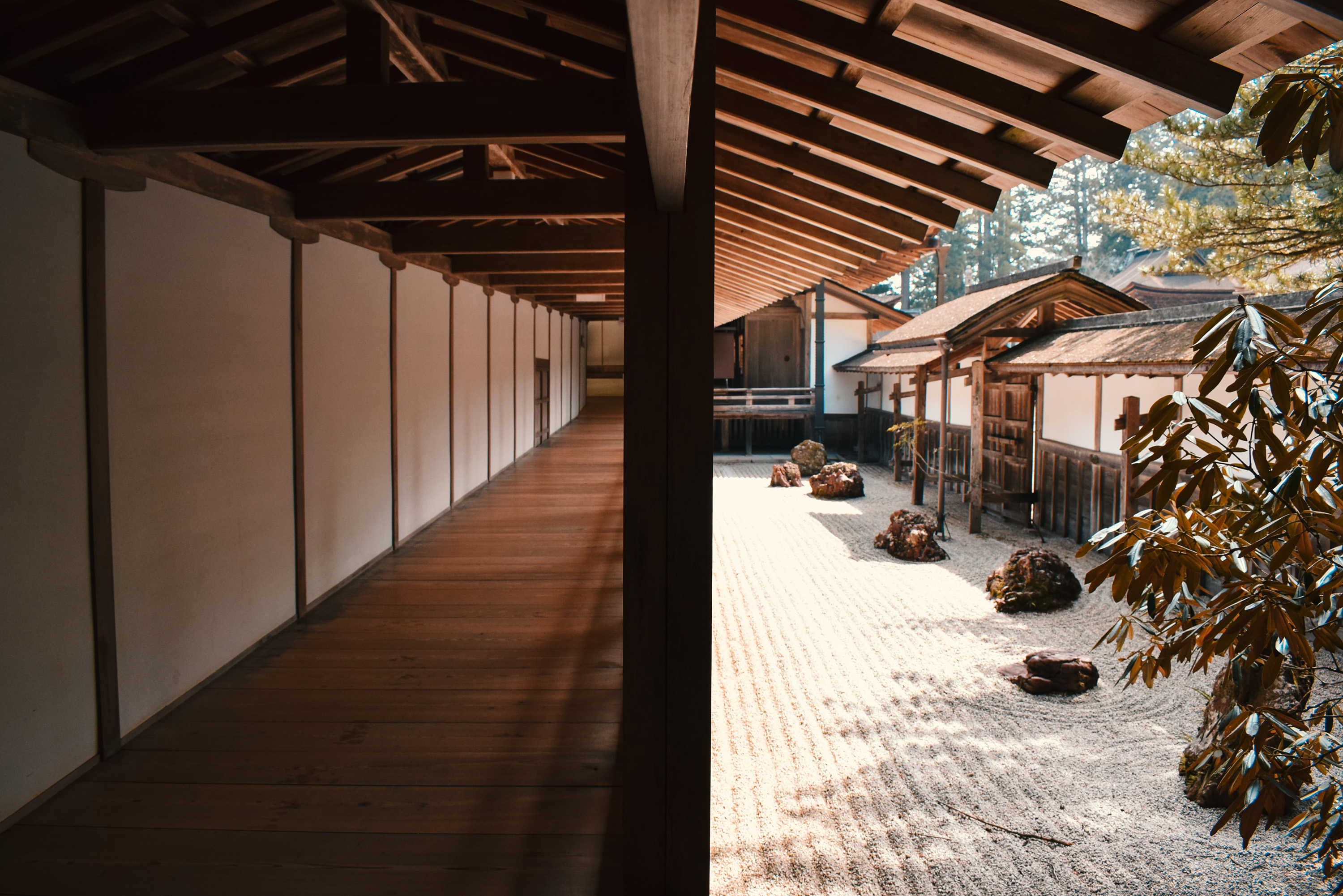
A rock garden looks stunning in any sized plot
(Image credit: Agathe Marty/Unsplash)
'Japanese rock gardens are all about embracing calm, balance and mindfulness,' says Jessica Smith, gardener and florist of Flower and Land. They are 'a place of retreat to reset after a day in our busy modern lives.'
'Think raked gravel instead of grass, to interpret water ripples,' she adds. Larger rocks can be used to resemble mountains, or islands, rising from the 'water' below. Light, small-sized gravel works well, and then, using a hand-held rake, create swirls and lengths of patterns – get creative! You can change the raked design every time, depending on how the mood takes you.
'Japan is a very mountainous land and is blessed with many different rocks, but rocks are heavy, so usually a garden is constructed with local stone,' says Jake Davies-Robertson, Botanical Horticulturist at the Royal Botanic Gardens, Kew.
'Stones are often selected or arranged to represent mountain ranges, cliffs, or rocky outcrops, or just because they are particularly beautiful.
'In many cases, the rocks are seen as more important than the plants in the garden, as in karesansai, or dry gardens. In karesansui, the plants provide a backdrop or small flourishes around the rocks.'
2. Go miniature with trees
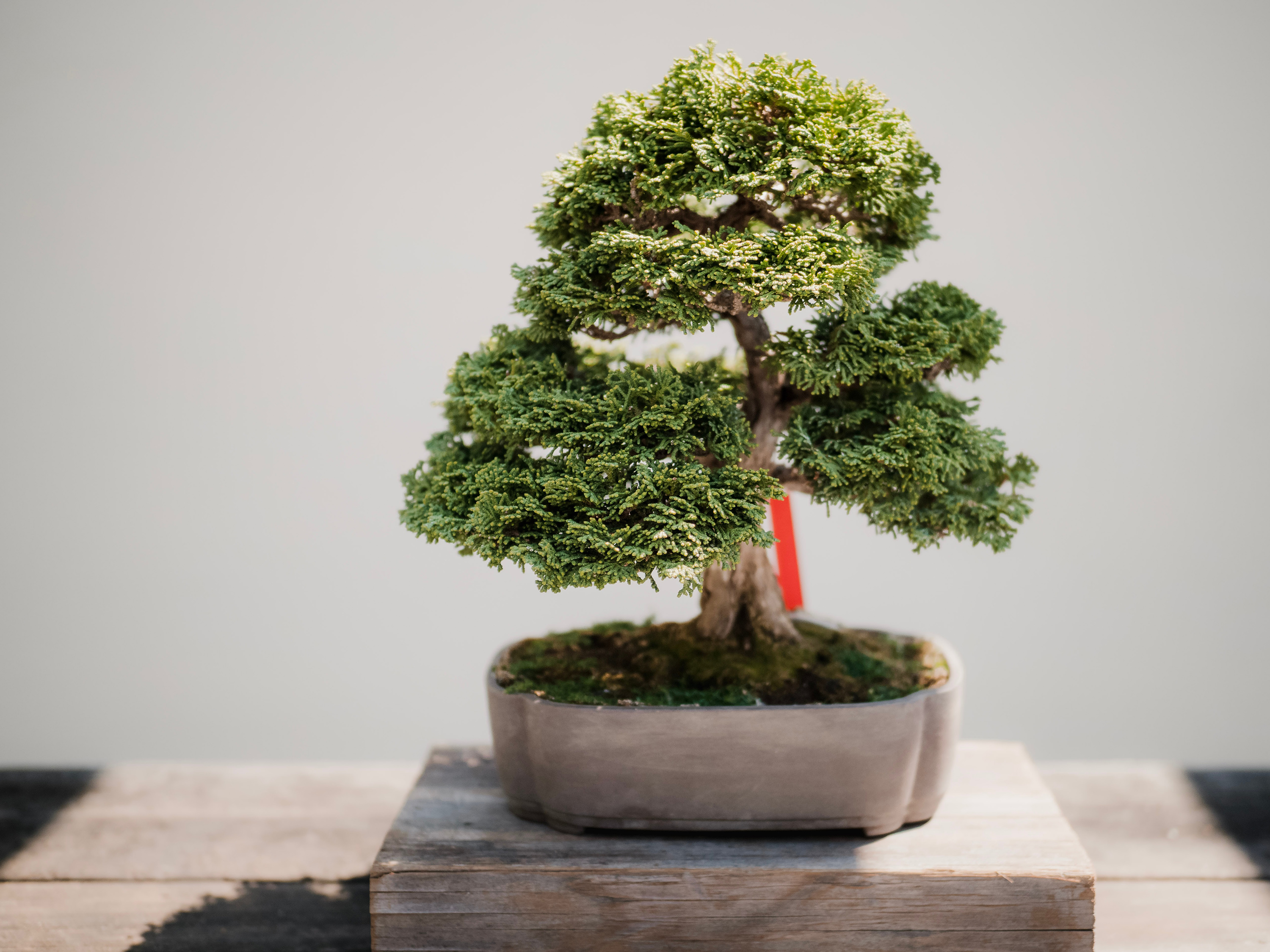
The wondrous bonsai makes a great addition to a garden shelf
(Image credit: Mark Tegethoff/Unsplash)
Jessica Smith, of Flower and Land, informs us that 'niwaki tree' translates into 'garden tree', and is when 'trees are grown and pruned to be scaled down, to fit into smaller spaces.'
You may also have heard of bonsai, often used in Kazuyuki Ishihara's award-winning gardens. Whilst niwaki refers to trees planted in soil, bonsai goes smaller again, for tiny trees grown in pots. Surprisingly, whether bonsai or niwaki, the genetic size of the trees' does not differ – as said by the RHS. They are just trained in slightly different ways!
For niwaki, popular evergreen varieties to choose from include box, Japanese privet, or pine. When it comes to bonsai, all kinds of trees can be trained. However, it's quite easy to find ready-trained varieties in garden centres, saving you a job.
So, why not add a niwaki tree as a stunning focal point to your small garden? Or, perhaps a bonsai or two, arranged on an outdoor shelf?
3. Have a go at cloud pruning
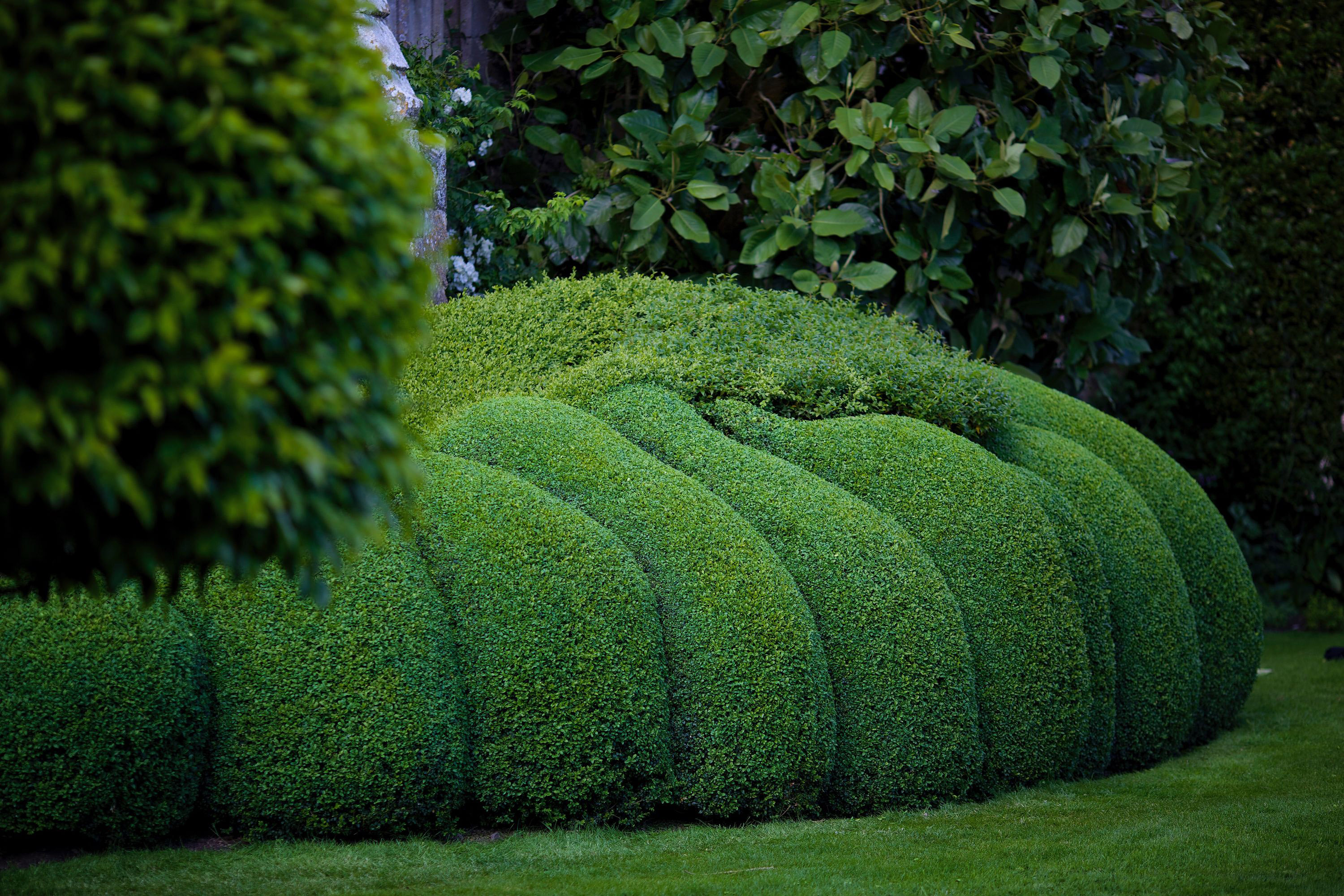
Hedges clipped into organic shapes are a stunning feature in Japanese gardens
(Image credit: Niwaki)
'Pruning is a key feature of Japanese gardens,' says Jessica Smith of Flower and Land. 'My favourite is cloud pruning, a method you often see in English topiary, but one that rings true to Japanese gardens the most.'
Niwaki is often pruned this way, but so are lower-lying shrubs – dwarf azaleas, for example, once their flowers are over.
'Trees, shrubs and hedges are clipped so closely and neatly with organic, curved, sweeping, and billowing shapes, echoing cloud formations,' Jessica continues. 'A gentle contrast to any straight lines and neat edges seen amongst the rest of the garden.'
The RHS advises to do so annually, in early to late summer, although faster growers may need double the amount. Jake Hobson, founder of Niwaki, shares some expert advice. 'Try to find a balance between what you want to do and what the plant wants to do – give the plant a bit of freedom to do its thing. Be confident, be brave, but know when to stop!'
Before you have a go, make sure your tools are up to the job. Take a look at our best secateurs if you're after a replacement.
4. Try colour-changing leaves with a potted acer
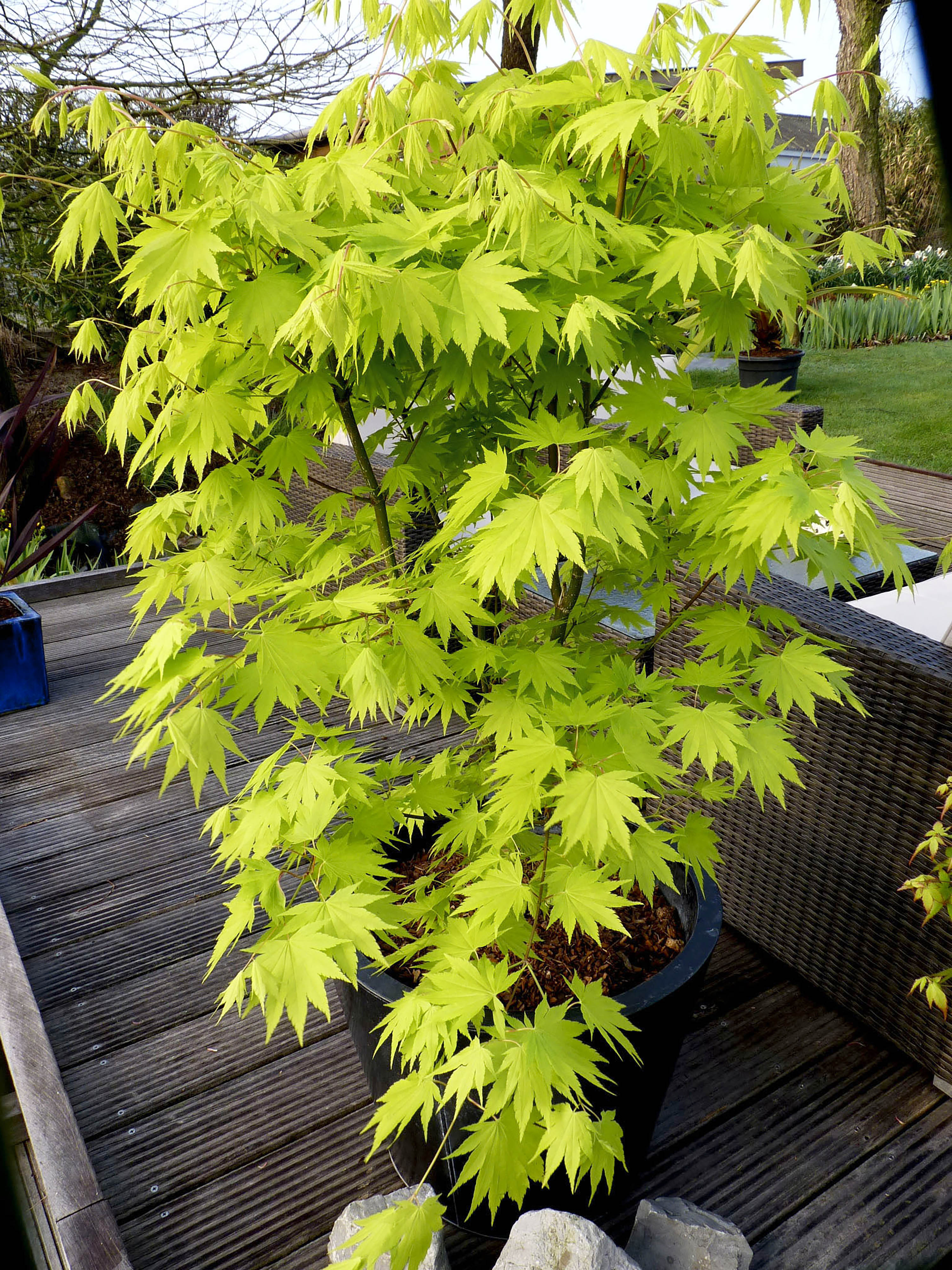
(Image credit: Suttons)
Acers, otherwise known as Japanese maples, are a species of tree with hundreds of different varieties. They are small-to-medium-sized and offer bold colour, which often changes from summer to autumn.
Simon Tetlow, Head Gardener at Tatton Park, describes their importance in the Japanese garden as being one of four principal actors for the garden's 'framed stage' – the other three being pine, azalea and moss.
For a dramatic spectrum of colour throughout the seasons, try Acer shirasawanum 'Jordan'. It has orange-yellow leaves in spring, which turn to a refreshing zing of green in summer, followed by a deep red in winter. It's great when positioned in a pot on a small patio, due to its compact form.
Love acers? Read how to grow acers and create year-round interest in your garden
5. Go for blazing red foliage
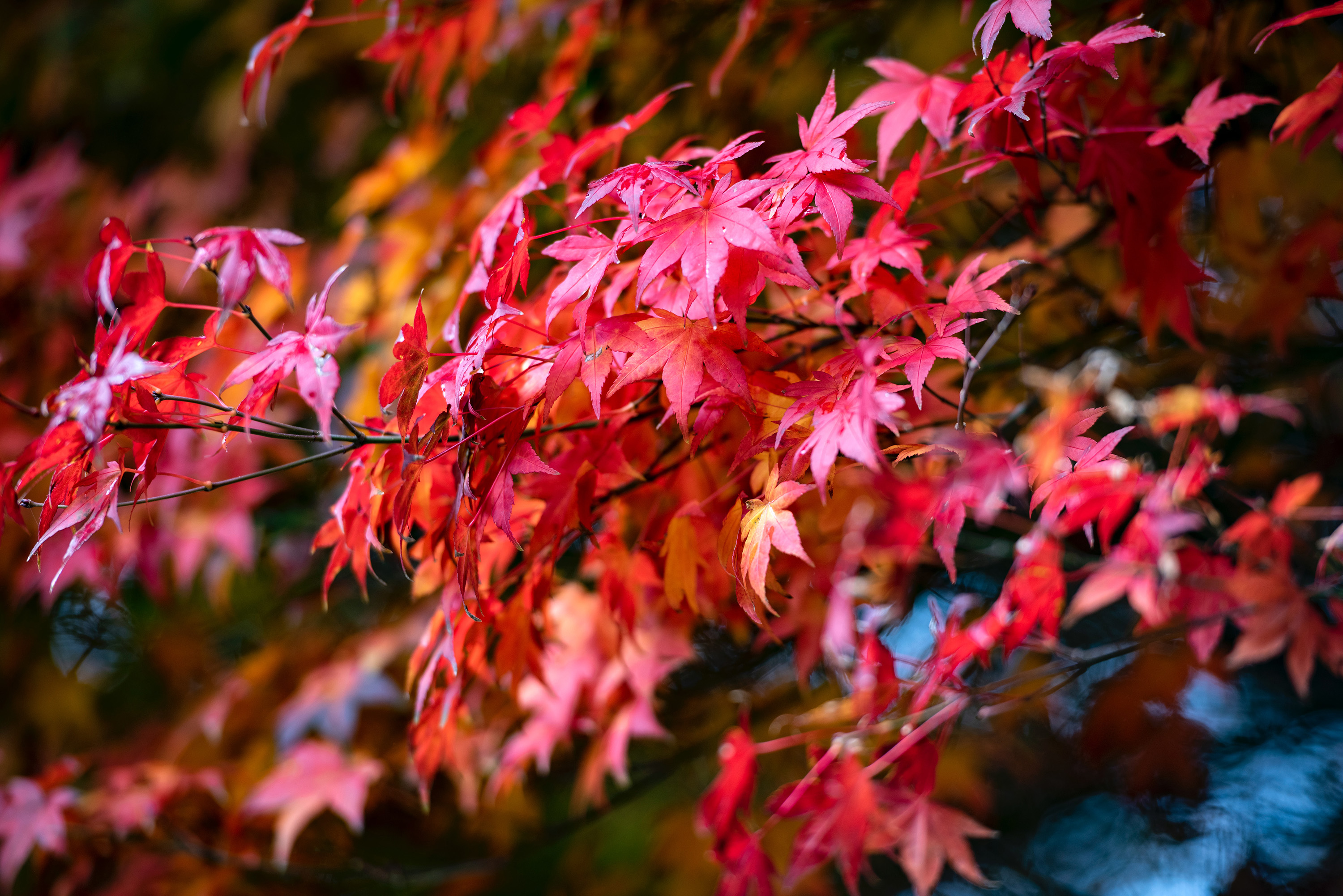
Acers provide show-stopping colour come autumn
(Image credit: William Milliot/Unsplash)
If you have a bit more space and want to really embrace the glorious acer, then why not go for something slightly larger? Acer palmatum 'Sherwood Flame' is a very popular choice for a larger tree but still suitable for small plots, as it grows up to 5m tall. Its leaves change from red-purple to bright crimson.
Simon Tetlow of Tatton Park suggests how taller acers can be trained by weighing branches down – to create low-hanging canopies. He also advises to shape them carefully – ensure they are open enough for light to filter through.
This will create an attractive, dappled shade which has the effect of 'moving light'.
6. Grow Japanese vegetables

(Image credit: Suttons)
If growing your own food is an important part of your garden, and you're opting for a Japanese style, then how about growing some Japanese vegetables?
The purple-skinned 'Murasaki' sweet potato has a nutty flavour and edible leaves. Plant it in spring for an August to September harvest. The 'Samurai' carrot is another Japanese variety, with bright red colouring and sweet flavour.
Or, why not try growing a 'Kabocha' squash? These small, green-skinned pumpkins have an orange flesh that's rich in nutrients and delicious for both sweet and savoury recipes.
We have lots of other small vegetable garden ideas, too!
7. Plant vibrant Azaleas
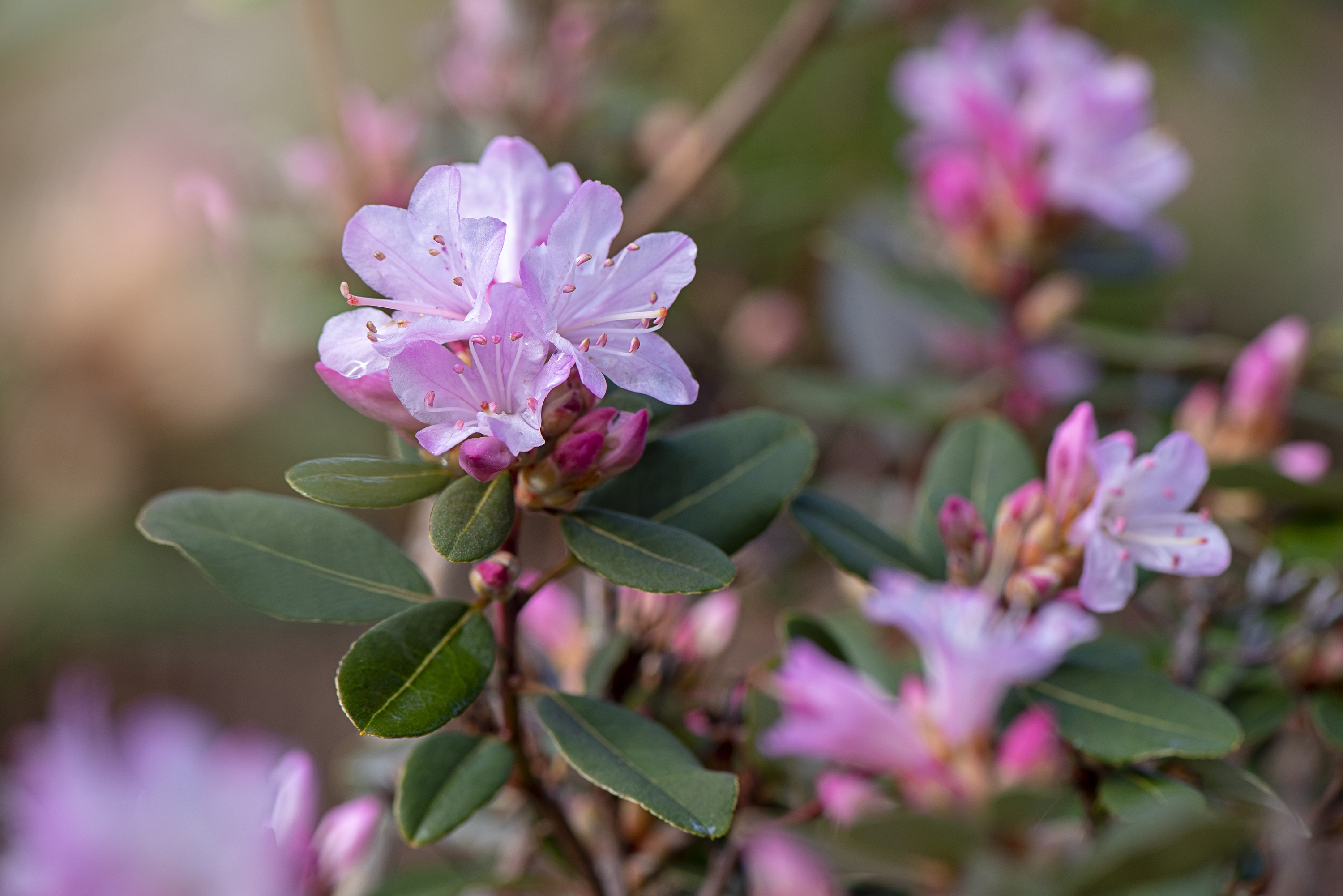
Evergreen, low-growing azaleas provide a burst of colour
(Image credit: Getty Images)
Azaleas are commonly seen in Japanese gardens, with their brightly coloured blooms. There are plenty of dwarf varieties to choose from, which suit small gardens perfectly.
Evergreen types will provide greenery all year and can be pruned to form shapes, such as spheres or the aforementioned clouds. You could experiment with 'O-Karikomi' where multiple plants are pruned together, to form one, dense shape.
They can grow happily in pots. Try Azalea japonica 'Diamond Red' for masses of red flowers, or 'Geisha Purple' for spectacular lilac blooms.
Check out our best shrubs for small gardens for more inspiration.
8. Fill the air with cherry blossom
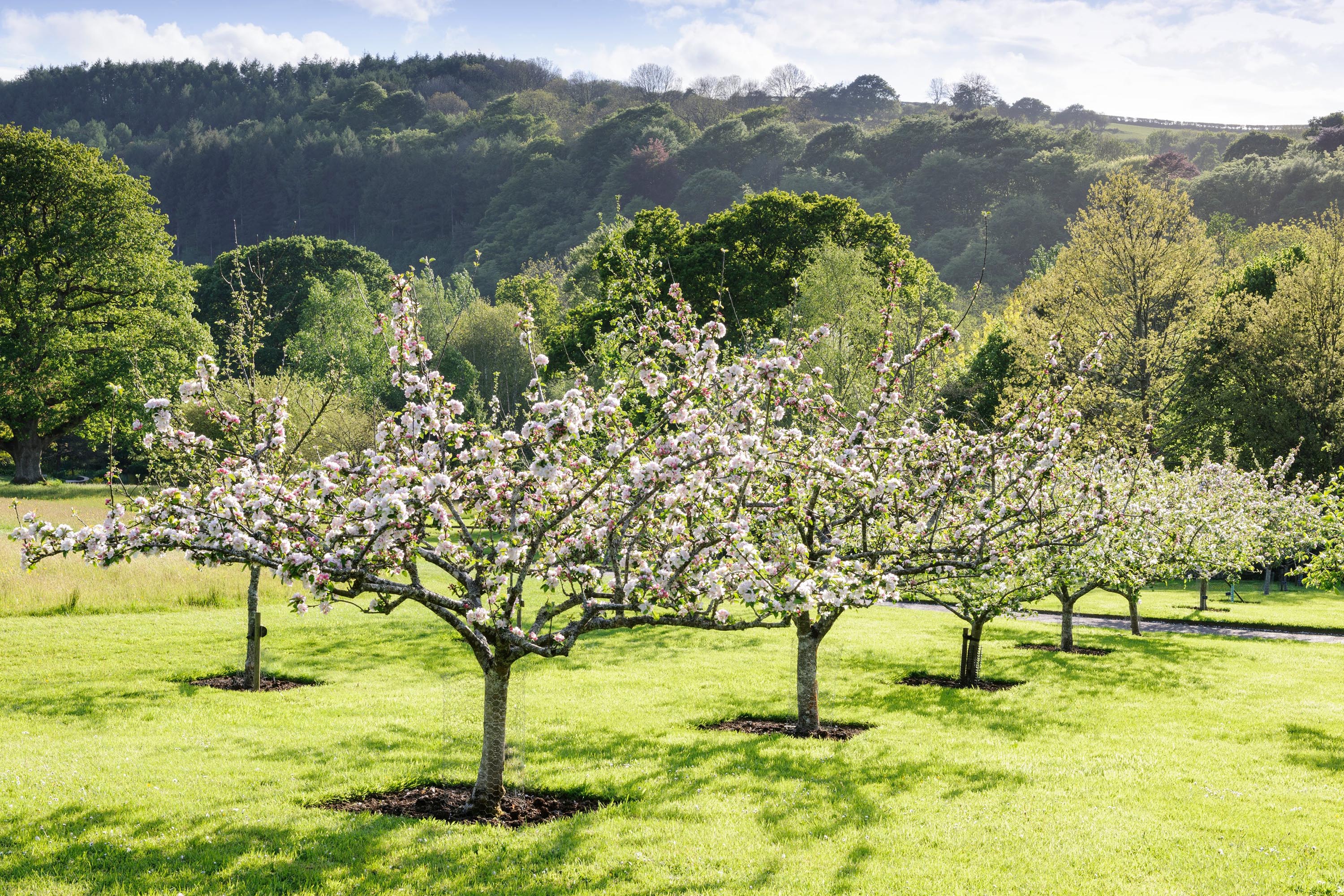
Beautiful blossom at RHS Garden Rosemoor
(Image credit: Jason Ingram/RHS)
When you think of Japanese plants, cherry blossoms may be one of the first that springs to mind. Their clouds of pastel-pink flowers in spring are truly stunning. They are perfect for small gardens, as they don't grow too tall.
'Accolade' has masses of semi-double flowers and a broad canopy, which you could tuck further plants and even seating beneath for a delightful view. It also benefits from autumn-colour, with its foliage turning a spectacular orange.
For a small variety, try 'Kojo-no-mai'. It's a perfect choice for pots as it grows only up to 2.5m tall, in a neat, compact shape. It has lighter flowers – more white than pink and again, offers autumn colour.
Take a look at our best trees for small gardens for more ideas.
9. Add a zen-like water feature
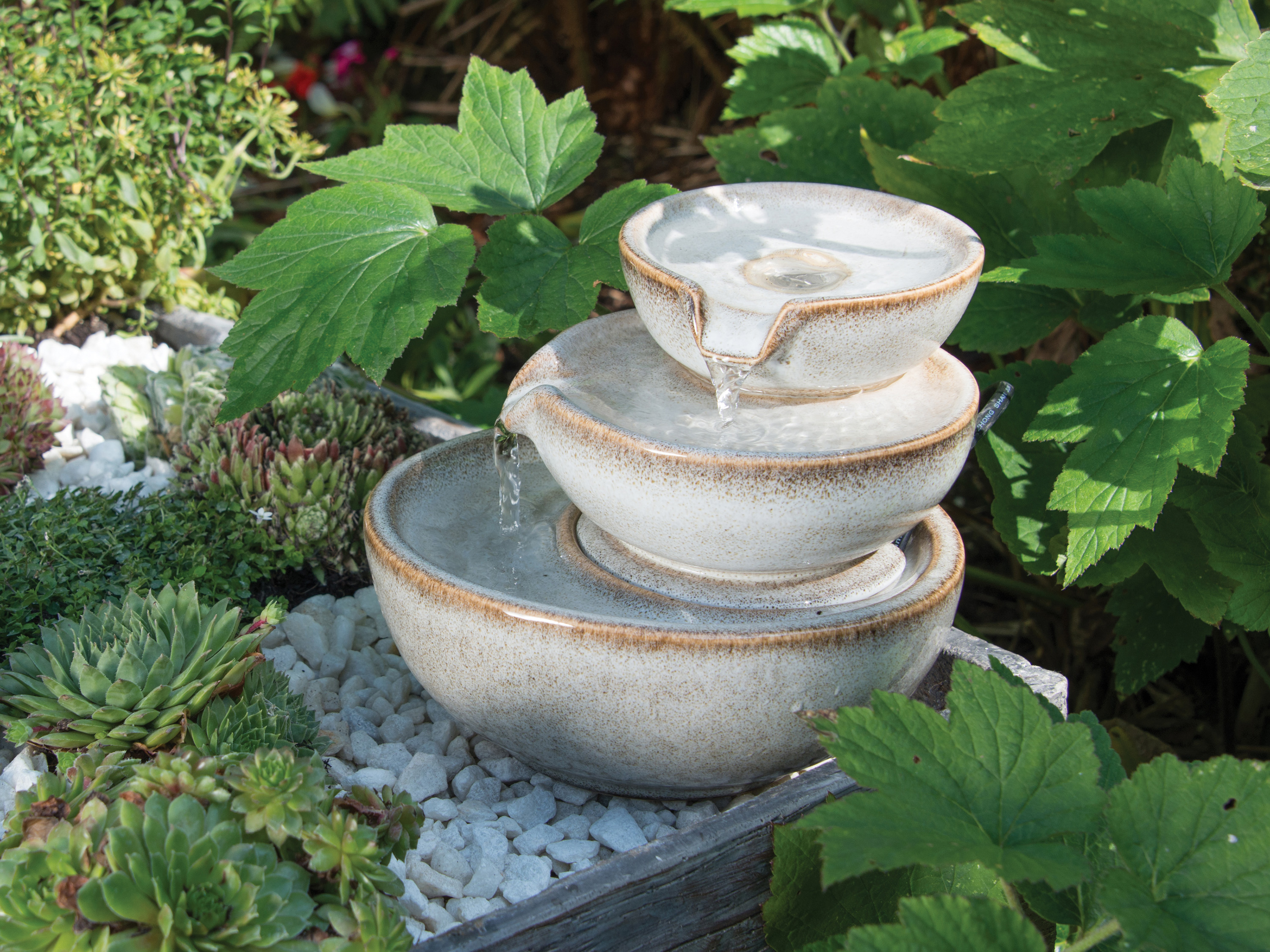
Introduce the soothing sound of water to your plot
(Image credit: Gardenesque)
Japanese gardens are calm places to be – and what's more calming than the gentle sounds and sight of running water nearby? Even in the smallest plots, water feature ideas will offer an extra boost of ambience. They are also good for passing wildlife.
Go for simple styles – think stone bowls, or how about a Shishi Odoshi? These are made of bamboo, and create a sound which was traditionally meant to scare away deer. However, the periodic sound is really quite soothing and will add to the sensory experience of your garden.
10. Go minimalist with outdoor furniture
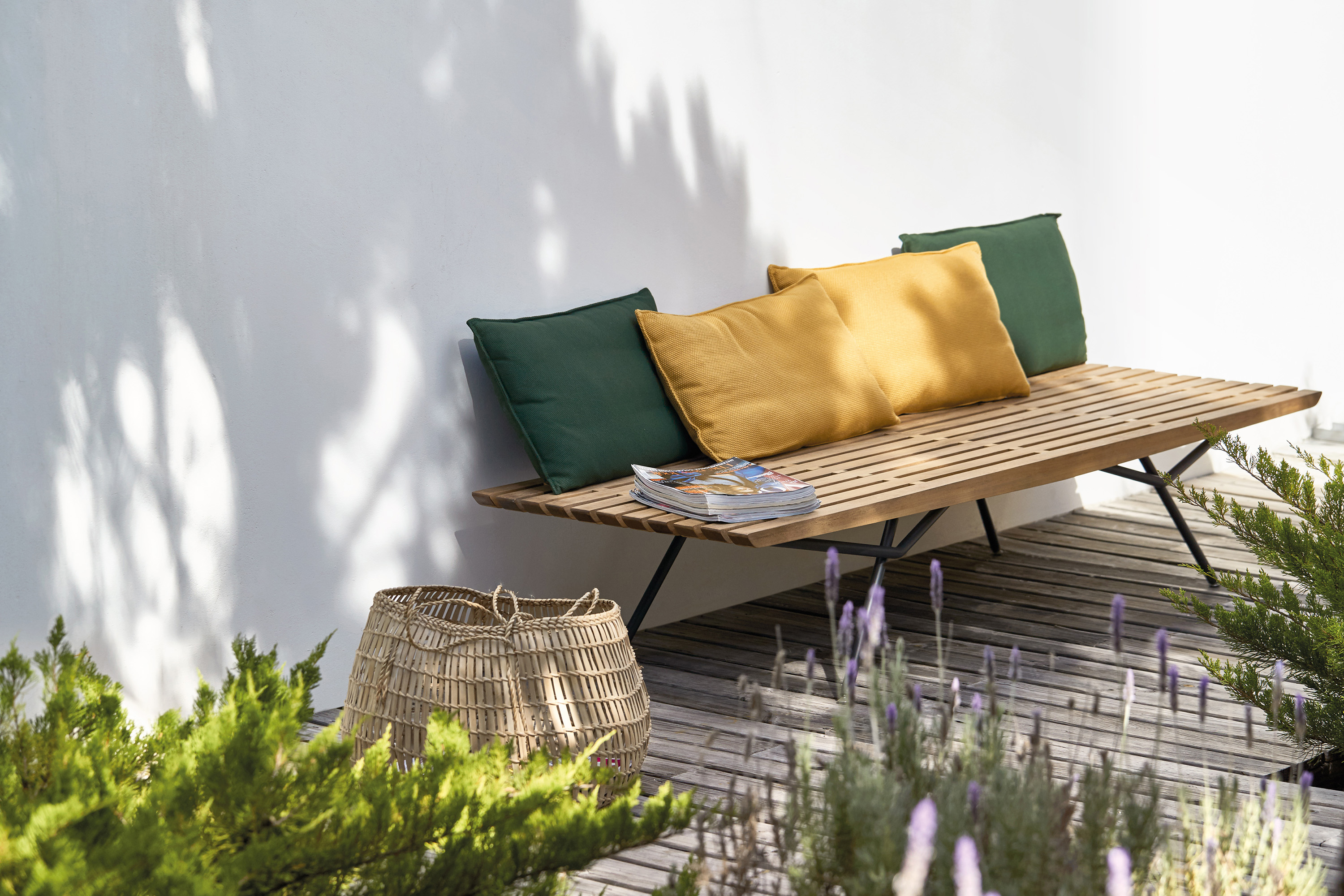
San Bench - Manutti from Go Modern Furniture
(Image credit: Go Modern Furniture)
Japanese style is all about simplicity, and this remains the case when it comes to furniture. So, when planning your outdoor seating area, choose simple lines and fuss-free design.
A wooden bench with scatter cushions made from natural fabrics makes a lovely place to sit and enjoy the ambience of your garden, whilst letting the surrounding nature take the spotlight.
11. Create a calming fish pond
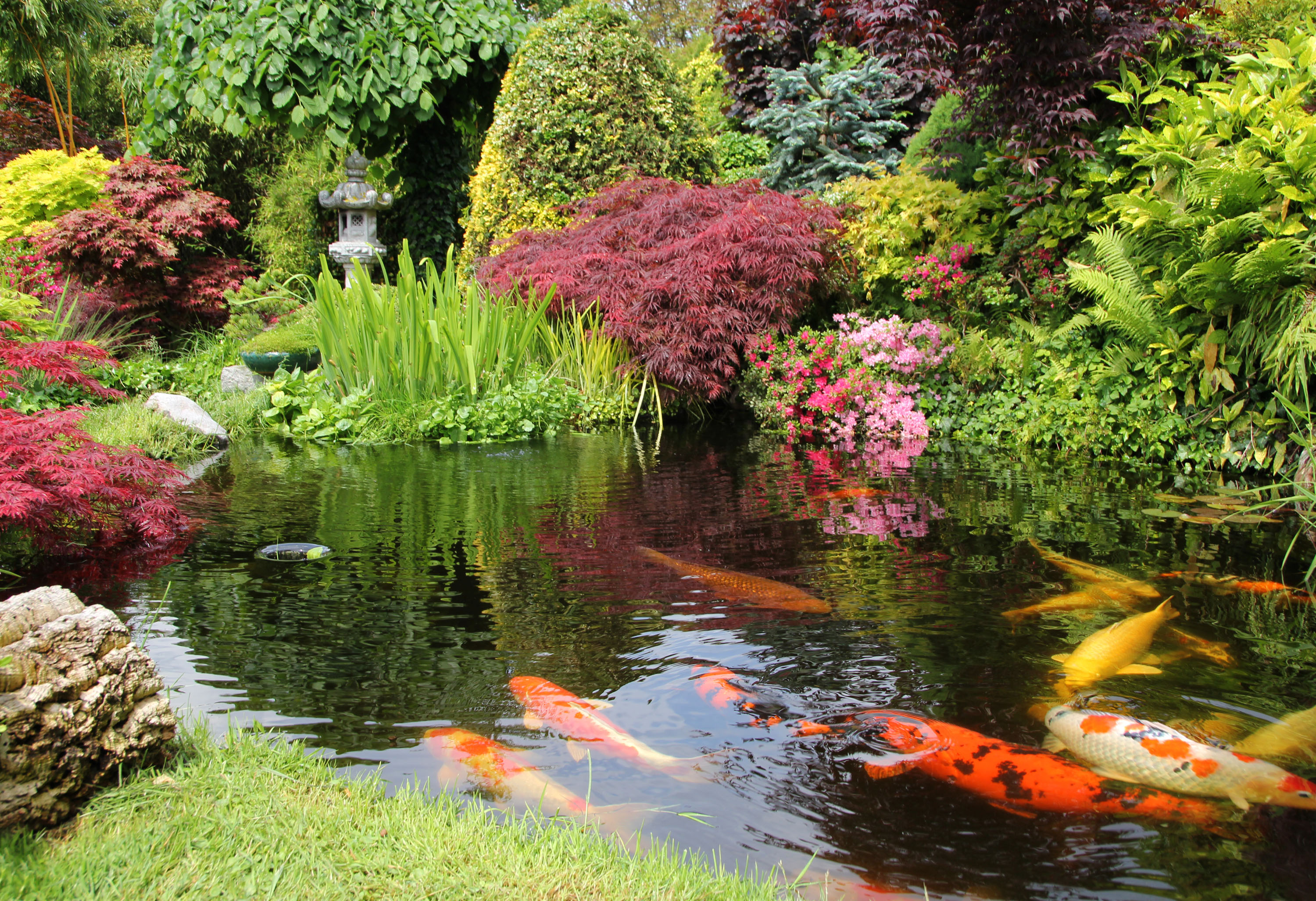
Choose goldfish rather than koi carp for smaller ponds
(Image credit: Getty Images)
Koi carp are often associated with Japanese culture, so it's no surprise that Japanese gardens often include a pond. However, koi can grow very large, and so need large spaces to accommodate – we're talking 4ft deep and at least 6ft wide.
Obviously, this isn't practical for small gardens, but choosing the smaller and easier-to-look-after goldfish will have just as good an effect. Similar to the koi, goldfish come in a variety of colours – from orange, red, white and black.
Look out for the Shubunkin variety, which is of Japanese origin, and has a spotted appearance and long fins.
12. Illuminate your space with pagoda-inspired lanterns
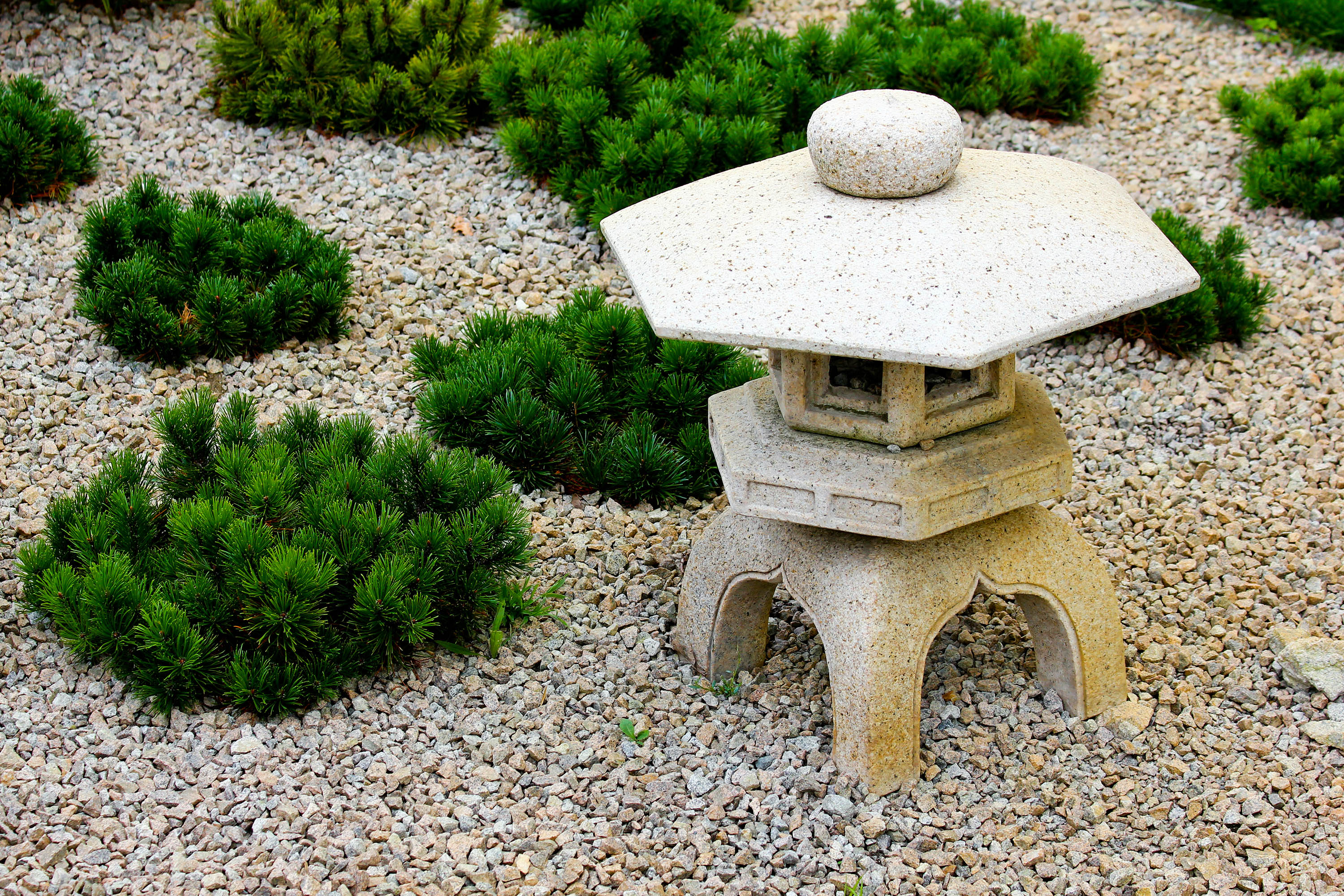
A lantern will provide interest in the day and a gentle glow at night
(Image credit: Getty Images)
Traditional pagoda-style lanterns in stone, wood, or even resin, give an air of authenticity and make eye-catching focal points. Tuck them amongst your acers and shrubs and place an LED candle inside when dusk settles. They will light up corners of the garden with a welcoming glow and instantly update the mood.
Try Wayfair for an affordable range.
13. Enjoy spring blooms with a miniature magnolia
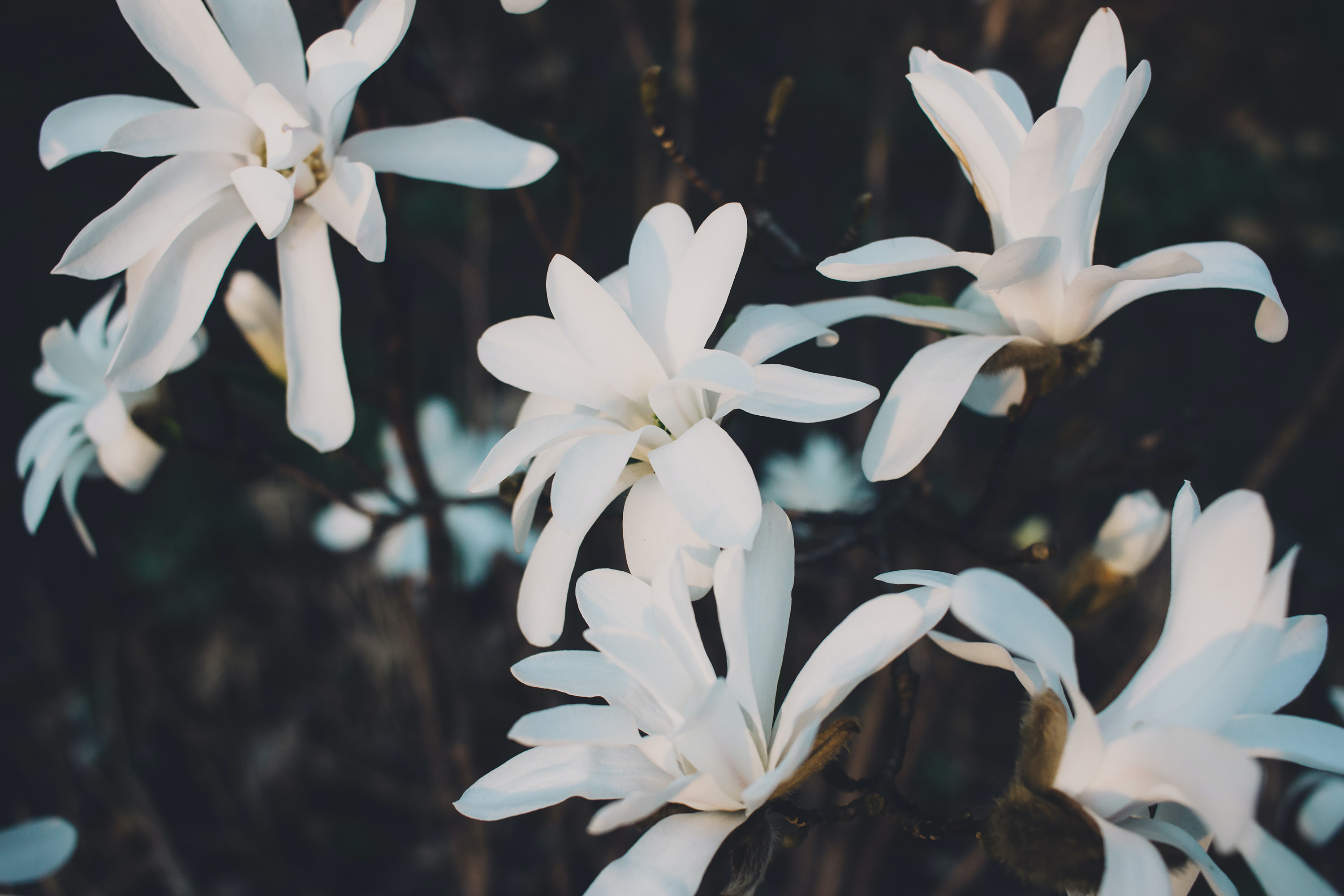
Magnolia stellata has stunning star-shaped blooms and does well in small plots
(Image credit: freestocks/Unsplash)
Magnolias are one of our favourites and make a beautiful addition to the small Japanese garden. Whilst many varieties are large, there are plenty of smaller trees to choose from. Even ones that are suitable for containers.
Magnolia liliiflora 'Nigra' is an award-winning, early flowering kind, with deep purple flowers and a compact structure. Magnolia stellata is another fantastic small-space option, featuring starry-shaped blooms in a dazzling white.
14. Create a path from stepping stones
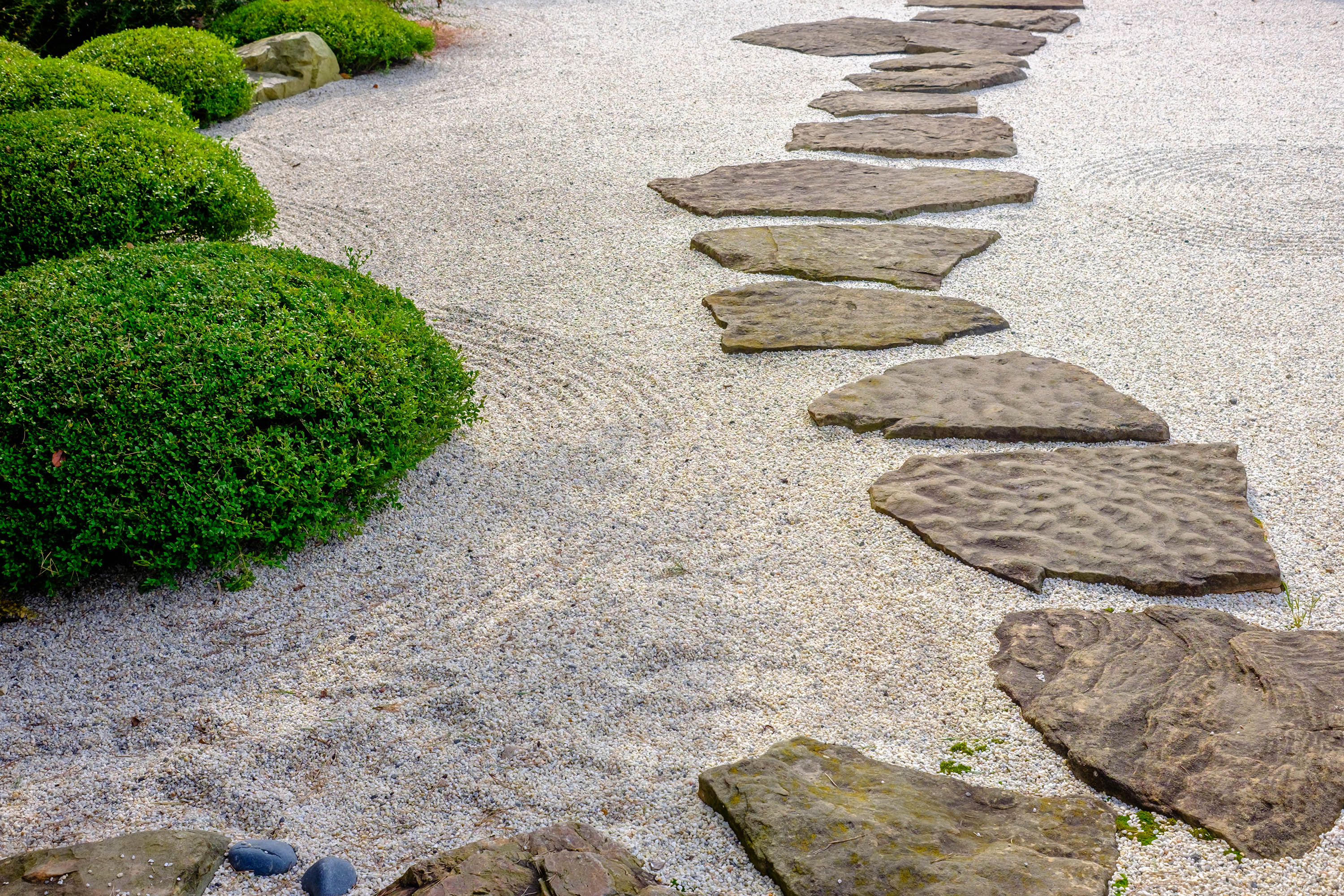
Add a winding pathway to your garden
(Image credit: Getty Images)
Stepping stones allow you to pay more attention to your surroundings, as you mindfully manoeuvre from one stone to the next. So why not use them to create a winding path through your beautiful Japanese garden?
Set into gravel, grass, or even moss, they will give your space a playful yet considered air, whilst helping you get from A to B.
We've got plenty more inspiration for you in our garden path ideas feature.
15. Get creative with moss
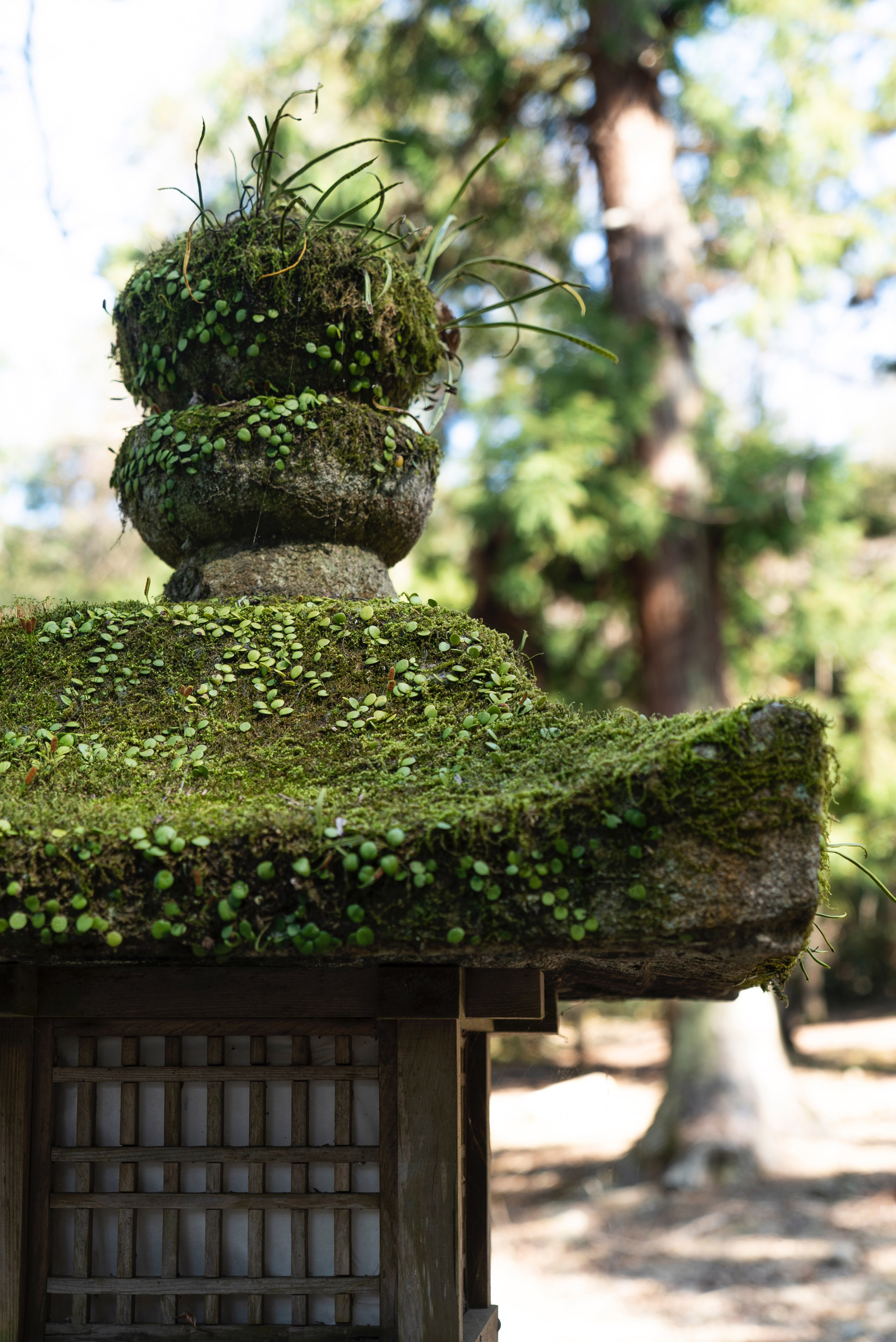
Moss is a popular choice for Japanese gardens
(Image credit: David Emrich/Unsplash)
Moss is a staple for many Japanese gardens. It is encouraged to grow in soft, carpet-like mats – covering rocks and garden ornaments in plush, cool mounds.
Not only does it add a sumptuous look, but it also cleans the air. It generally needs quite humid conditions and a bit of sun – if the conditions are right, it will begin to spread. If you're adding moss to soil, ensure it is weed-free and well-watered first, then press the pieces of moss against it.
To cover rocks, you can blitz pieces of moss up in a blender, along with water, and buttermilk or beer (make sure you wash the blender thoroughly afterwards!). Then, spread the mixture across the surfaces, where it should start to grow.
16. Try a striking colour scheme
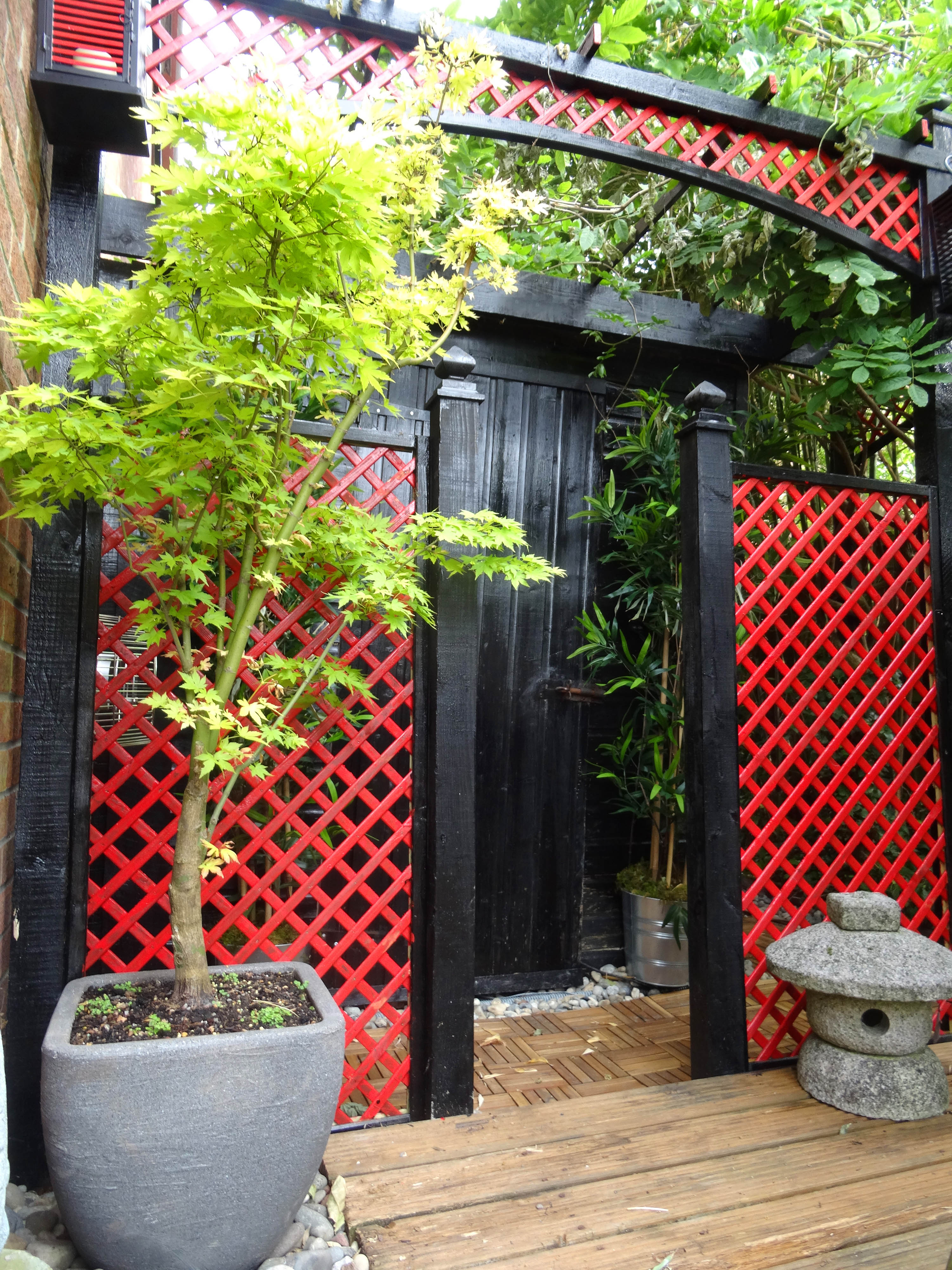
Use black and red for a bold look
(Image credit: Getty Images)
Have you noticed how Japanese gardens often feature a bright red bridge, gracefully arching across a flowing stream or pond? Whilst this might be a little on the large side for your plot, you can still add splashes of Japanese-inspired colour to get the same effect.
How about painting a trellis, a small pagoda, or a fence in a bold crimson? You could complement it with the addition of black, for a really striking palette.
17. Train wisteria up trellises
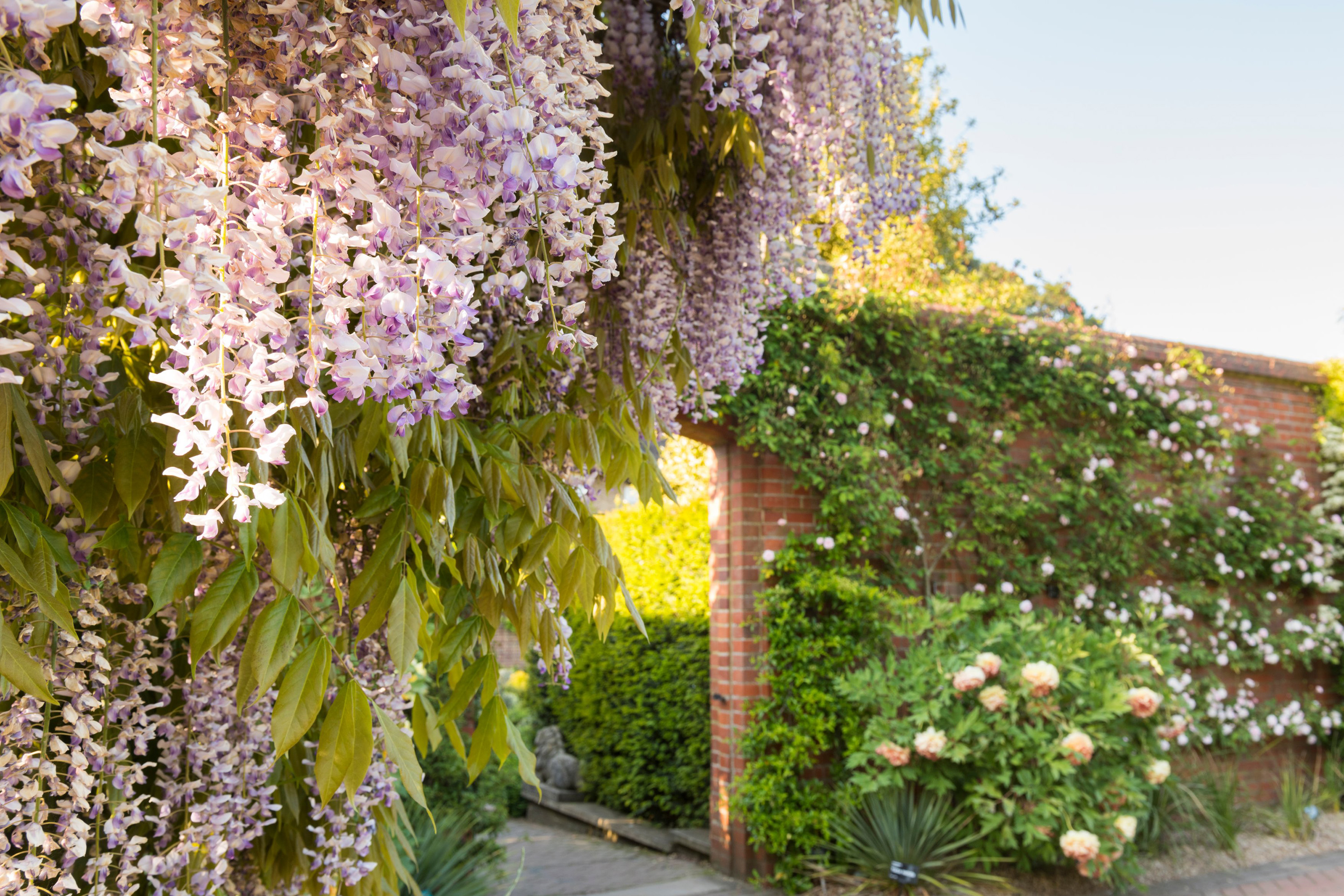
(Image credit: Joanna Kossak/RHS)
Wisteria looks almost magical, with its elegant cascades of blossom. In Japan, thousands flock to admire the wisteria tunnel at the Kawachi Fuji Gardens come spring, and it's easy to see why.
Although a tunnel might be a step too far, wisteria can still flourish in smaller plots – just be sure to prune it properly, twice annually. 'Domino' produces scented, blue-lilac flowers from a young age, and looks stunning supported by a garden fence or sturdy trellis.
You can follow our expert tips on how to grow wisteria in our guide.
18. Add height with bamboo
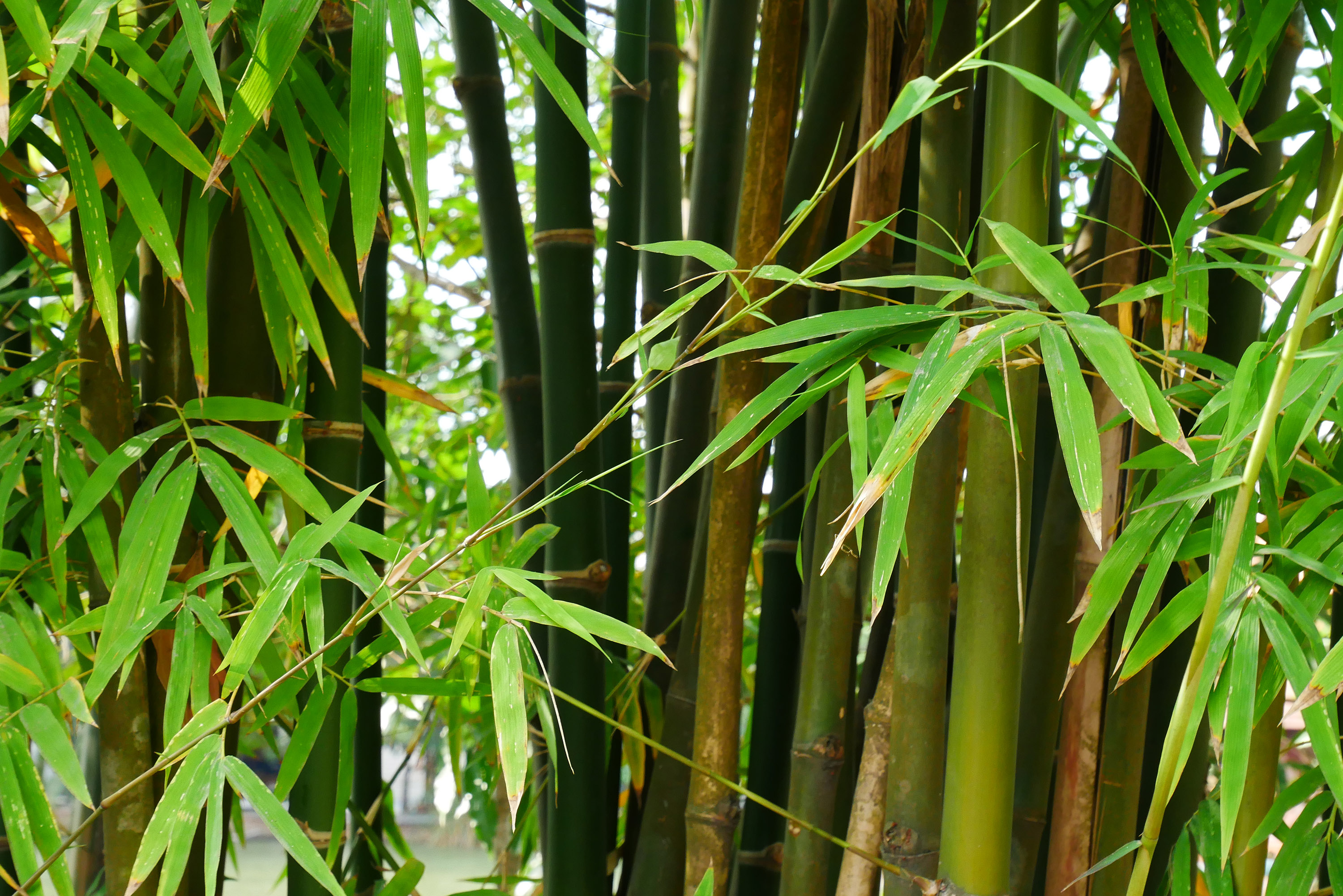
Bamboo can be used for screening or as a backdrop to borders
(Image credit: Getty Images)
Keep bamboos under control and they can offer stunning structure and foliage to even the smallest of plots. Choose clump-forming varieties to avoid them running rampant across your garden – the RHS suggests Fargesia, Bambusa, or Himalayacalamus, to name a few.
Planted in moist, but well-drained soil, bamboo can create lush green screens for privacy, or be positioned at the back of borders for height and interest. The team at Gardeners' World suggests Fargesia murieliae 'Luca', for pots, and Himalayacalamus hookerianus, for striking, colourful stems in hues of blue to gold.
What plants are in a Japanese garden?
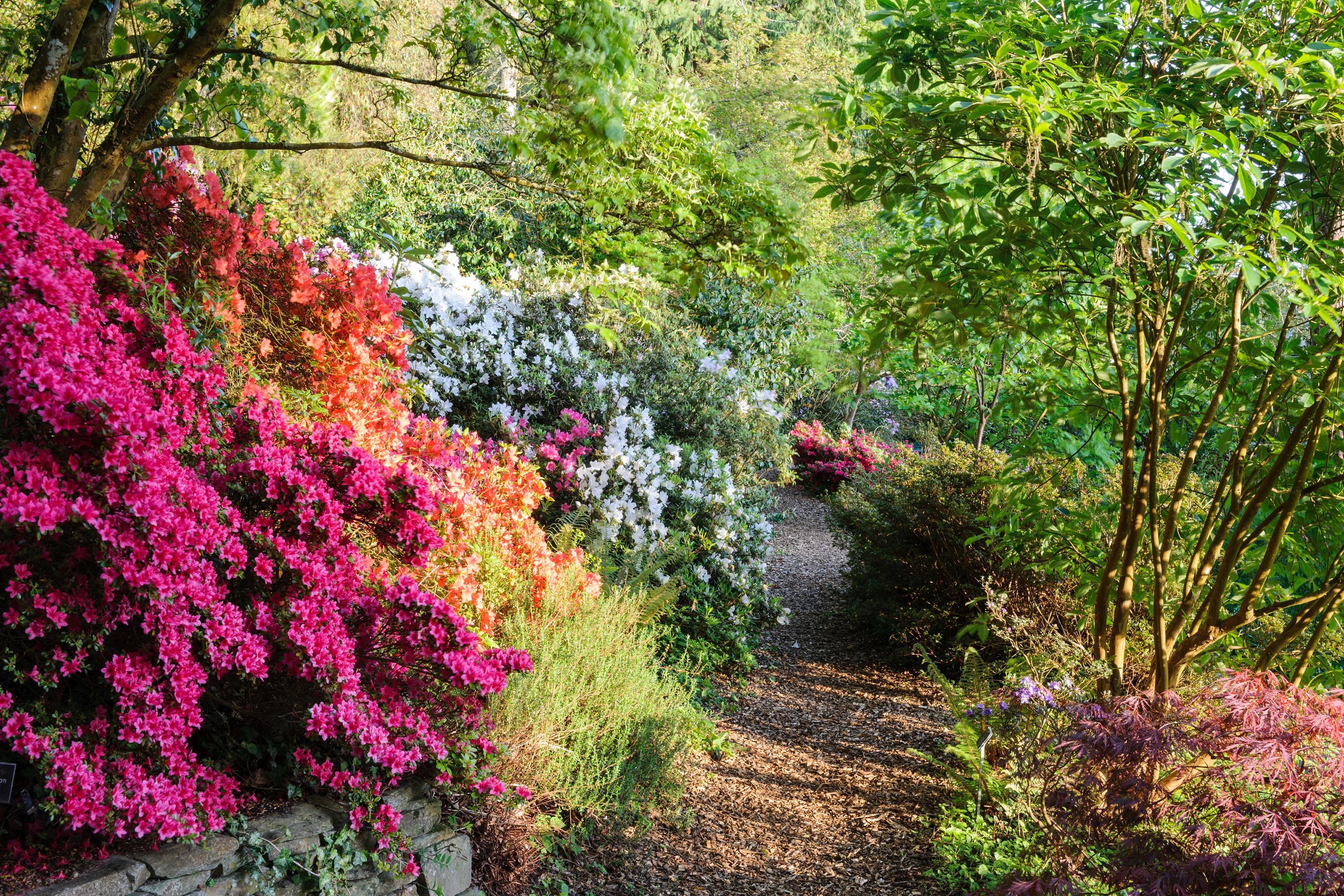
Azaleas in the Woodland Garden at RHS Garden Rosemoor
(Image credit: Jason Ingram/RHS)
As we've mentioned, popular Japanese garden plants include acers, azaleas, bamboo, moss, magnolias, and cherry blossoms. But, if you're after even more plants to fill your Japanese-inspired space, you're in luck.
Rhododendron – azalea's big sister – can be seen in larger gardens, as can hydrangeas with their showy heads full of blooms. Ornamental grasses are another good addition – try Ophiopogon planiscapus 'Nigrescens' for striking purple-black leaves. Ornamental quinces add colour for early spring (try 'Geisha Girl' for apricot-hued flowers), as do camellias.
Gardeners' World also suggests Hakonechloa macra – Japanese forest grass – to soften edges of paths.
'Another common Japanese garden plant is Nandina domestica or Sacred Bamboo, which although it is not a bamboo, has attractive foliage, flowers and fruit,' adds Jake Davies-Robertson from the Royal Botanic Gardens, Kew. 'My Nandina has moved house with me about four times now, and if it starts getting too big, it can be easily pruned.
'Alternatively, there are dwarf cultivars available, such as 'Fire Power', which has a more vibrant red leaf in autumn.'
How do you arrange rocks in a Japanese garden?
Traditional Japanese rock gardens offer a restful view for the eyes and inspire a feeling of peace and stillness. So, when you start creating your rock garden, keep it simple.
In other words, don't cram every rock you can find in a jumbled heap of a rainbow of colours – instead, pick carefully, and think what each stone could represent. An upturned, vertical stone could symbolise a mountain, for example. A smaller, smoother one in front, surrounded by fine gravel, could represent clouds.
Stick to groups of three or odd-numbered clusters – it looks more aesthetically-pleasing than even numbers. And remember that large rocks need to be secure to the ground. So, don't simply place them, where they could be knocked over. Instead, make sure they are properly set into the soil or gravel around them, perhaps with a bit of shallow digging first.
Why are Japanese bridges painted red?
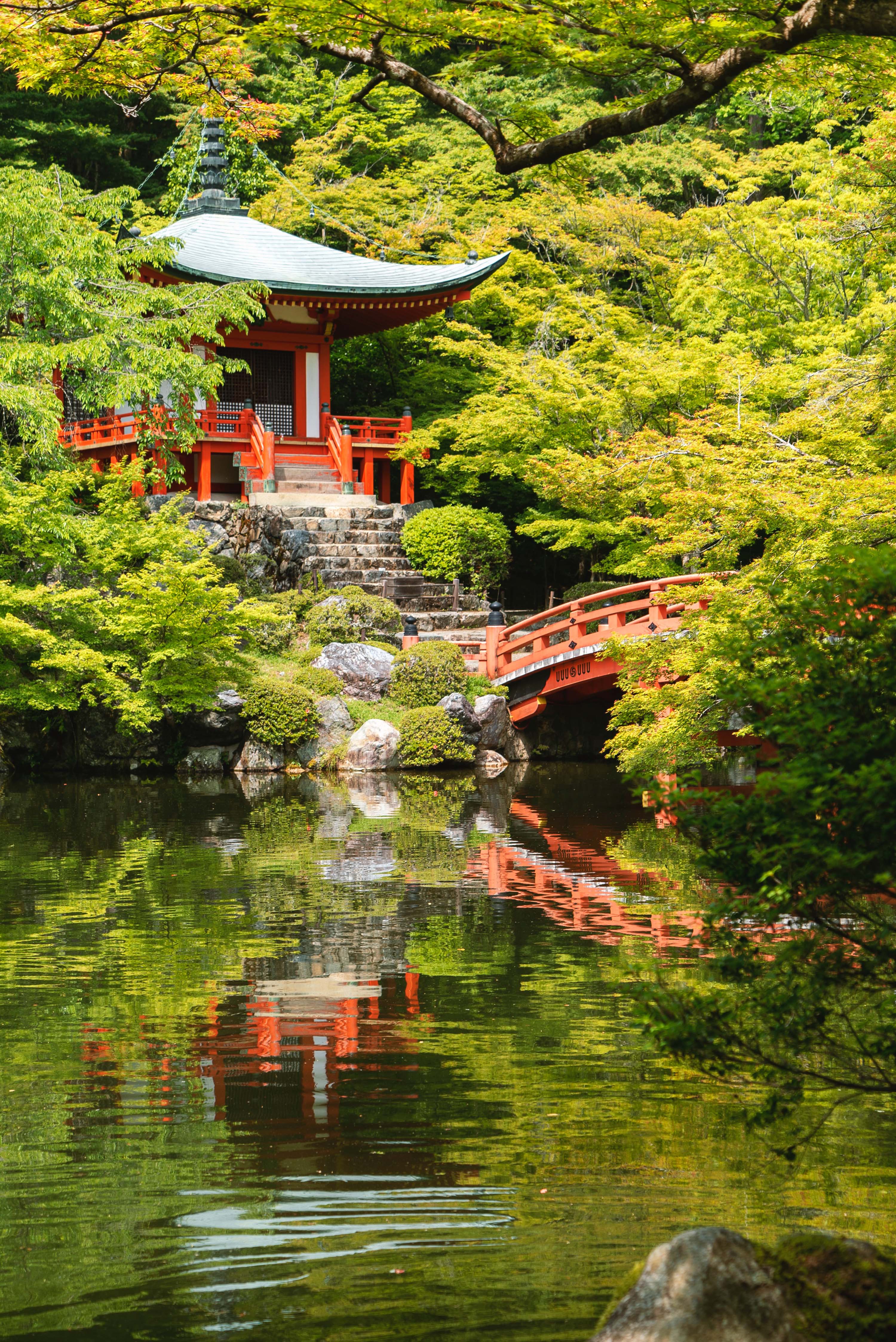
A Japanese red bridge – otherwise known as a guzei – offers a pop of striking colour amongst greenery
(Image credit: David Emrich/Unsplash)
The Japanese red bridge, otherwise known as a guzei, is a familiar sight for many. But why are they red?
Well, in Japan, the colour red is intertwined with various meanings, such as zen, transformation, and wisdom. Painting a bridge red, therefore, symbolises the inner-growth that you can experience when crossing over it, writes James Stedman for Bigblogofgardening.com.
They also make a striking focal point amongst other Japanese garden scenery which is, predominantly, a sea of greens.
Read more:
- How to make a small garden look bigger: cheat your way to a larger space
- Garden design ideas: all the inspiration you need for your project
- Tropical garden ideas: create an exotic-inspired space
Zen Garden Ideas For Small Gardens
Source: https://www.gardeningetc.com/design/small-japanese-garden-ideas
Posted by: denhamgoolifter.blogspot.com

0 Response to "Zen Garden Ideas For Small Gardens"
Post a Comment